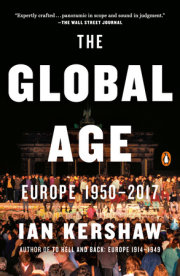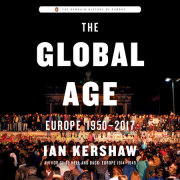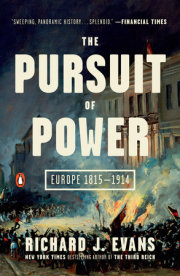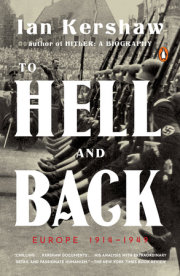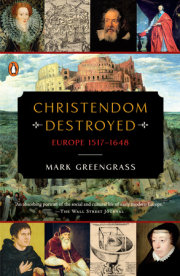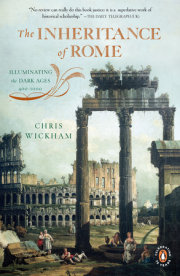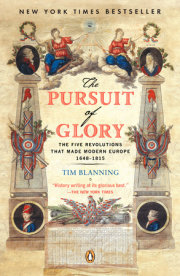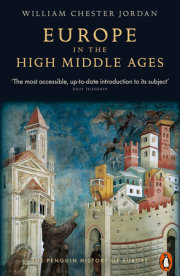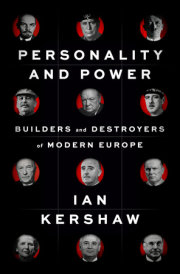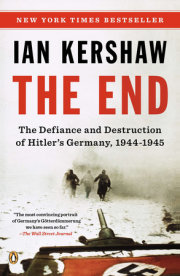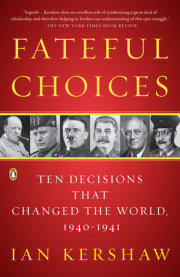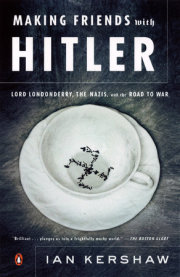1The Tense Divide . . . it is likelier to put an end to large-scale wars at the cost of prolonging indefinitely a ‘peace that is no peace’.
—George Orwell, on the atomic bomb, 1945
By 1950, as the immediate aftermath of the Second World War subsided, a new Europe, riven in two – ideologically, politically and socio-economically – had emerged. It was the beginning of a completely changed era in the continent’s history, one of unprecedented insecurity. It was an era intrinsically shaped by the division that the war had left as its overriding legacy – and by the appalling threat of nuclear annihilation.
For more than four decades the Cold War was to drive the two halves of Europe apart. The largely separate development took place, however, with one vital feature in common: the primacy of military power. This military power, the dominant feature of post-war Europe on both sides of the Iron Curtain, was now controlled by only two countries: the United States of America and the Soviet Union. Both were preoccupied with security. Both were determined to prevent the enemy dominating Europe. The novelty in their tense relationship was that it rested ultim- ately on weaponry of such fearful destructiveness that neither side dared use it. Within the space of only a few years it became the power of com- plete destruction. Both the United States and the Soviet Union – one already a superpower, the other on the verge of becoming one – had built atomic bombs by 1949. Four years later both the USA and the USSR had acquired the immensely more powerful hydrogen bombs and were soon in possession of nuclear arsenals capable of destroying civilized life on the planet several times over.
During the years 1950 to 1962 the Cold War was at its most intense, and most dangerous. For much of this period Europe was the centre of the Cold War – though in a nuclear age superpower confrontation anywhere on the globe could have had the direst repercussions for the European continent.
THE HEAT OF THE COLD WAR
The emerging conflict between the United States and the Soviet Union in the immediate post-war years had been threatening at times but had avoided disaster. No sooner had the new decade begun, however, than a dangerous crisis threatened to have grave consequences. That the crisis erupted over distant Korea was the most obvious indicator that Europe could not avoid being part of a global conflict between the superpowers. Whereas before 1945 the United States had been reluctantly drawn into European affairs to fight intwo world wars, Western Europe now became in essence an appendage – if an important one – of American foreign policy. Meanwhile the eastern bloc (apart from Yugoslavia, which had in the aftermath of the war successfully asserted its independence from Moscow) was even more directly committed to support of the USSR in its worldwide confrontation with the USA.
Korea had been annexed by the Japanese in 1910 and ruled by them until the end of the Second World War. The Korean peninsula was then divided more or less in half at a demarcation line on the 38th parallel by an agreement between the Americans and Soviets to split the administra- tion of the country temporarily. By 1948 expectations of a reunited Korea had disappeared. The division congealed into a communist republic in the north, effectively a Soviet satellite and seen by Moscow as part of the Soviet sphere of influence, and a vehemently anti-communist republic in the south, dominated by American interests. But the victory of communism in China in September 1949, after more than two decades of bitter civil war with Chiang Kai- shek’s Nationalists (which had run alongside the immensely bloody war against the Japanese invaders between 1937 and 1945), had left the Korean peninsula exposed. The south remained a non- communist enclave in a vast region of communist dominance. When, on 25 June 1950, the North Koreans crossed the demarcation line and attacked the south of the partitioned country, superpower confrontation escalated dangerously. The United States, committed to the containment of Soviet power and highly allergic to the prospects of further expansion of communism, in Southeast Asia as well as in Europe, could not con- template the loss of South Korea and the evident threat that Japan would then face.
The Americans correctly presumed that the North Koreans would not have attacked without Stalin’s authorization. The Soviet dictator had, in fact, given a green light some weeks earlier, though he was unwilling to send combat forces, looking to the Chinese to provide military assis- tance, if necessary. The American leadership took the view that communist expansion had to be halted there and then if a domino effect were to be prevented. If the fall of Korea were not arrested, argued President Harry Truman, then the Soviets would ‘swallow up one piece of Asia after another’. And ‘if we were to let Asia go, the Near East would collapse and [there was] no telling what would happen in Europe’. Not for the last time in post-war Europe, the failed appeasement policy of the 1930s was cited as a motive for military action. The appeasers had failed to stop Hitler. If the communist advance were not now stopped in its tracks, it would lead to a third world war.
The United States gained the backing of the United Nations, estab- lished in October 1945, to use force to defend a member nation under attack. This was the first time that this had happened, and it arose from a Soviet mistake. Both Stalin and the United States leadership were satisfied, when it was agreed at the Yalta Conference in February 1945 to create the United Nations Organization, that they would have the right of veto in any vote in the envisaged Security Council, whose five perman- ent members would also include Britain, France and China. Through a Security Council controlled by the great powers, it was imagined that the United Nations would prove far more effective than the League of Nations had been. The fallacy of such a presumption was to be repeatedly demonstrated during the Cold War when the use of the veto by one or the other superpower almost invariably produced stalemate on the Security Council. The exception was in 1950 when a temporary Soviet boycott of the Security Council in protest at the refusal to give a seat to Communist China enabled approval for the aid necessary to repel the invasion of South Korea and to re-establish peace and security. Stalin quickly realized his error and the Soviets again took their seat on the Security Council. But it was too late to stop a United Nations Command force, dominated by the USA, being sent to support the South Korean military. By the time the war ended the United Nations Command, which had incorporated the South Koreans, totalled almost 933,000 troops. The overwhelming majority of them were South Koreans (591,000) and Americans (302,000). A number of European countries – Britain and, with far smaller contingents, France, Belgium, Greece and the Nether- lands, along with a tiny contribution from Luxembourg – sent combat troops.
The Americans took the initiative throughout, expelling the North Koreans from the south, then pushing on beyond the demarcation line and into the north. Fearful of outright hostilities with the United States, Stalin rejected North Korean requests for Soviet intervention. The Chinese leader, Mao Zedong, however, was not prepared to see Korea fall wholly under American control, perhaps offering a gateway to an attack on a future date on China itself (whose relations with the Soviet Union were already less than harmonious). In autumn 1950 Mao had dispatched a sizeable force, eventually numbering about 300,000 troops, and forced the US Eighth Army into panicky retreat. It was a first indication that the West would have to reckon with China as a major military power. Within two months, the whole of North Korea was again under communist control and the South Korean capital, Seoul, had fallen. An alarmed Washington considered dropping an atomic bomb.
The United States still possessed a huge supremacy – 74 to 1, according to some estimates – in operational atomic bombs, compared with the Soviet Union. But what, exactly, would be the targets? In a war fought overwhelmingly in the Korean countryside, this was not obvious. And the prospects of a massive retaliatory escalation of what was a regional war, possibly extending to a Soviet invasion of Western Europe, or even atomic bombs dropped on European cities, had to be contemplated. Towards the end of 1950 the prospect of the widening of the conflict lead- ing to a third world war was a very real one. The American military leadership had drawn up a list of Russian and Chinese cities as targets and considered delivering an ultimatum to China to retreat beyond the Yalu river. If necessary there would be a resort to ‘prompt use of the atomic bomb’.
Wiser counsels prevailed. And by spring 1951, by which time the Chinese offensive had been blocked with much bloodshed, the Americans had regained the initiative, and the UN Command troops had eventually forced back the communist army. For the next two years both sides remained mired in a horrible war of attrition. In the armistice con- cluded in July 1953 the Korean War ended much as it had started, with each side behind the demarcation line at the 38th parallel. The three-year bitter war had cost the lives of nearly three million dead and wounded – the vast majority of them Koreans from both sides of the divide. American casualties numbered almost 170,000, over 50,000 dead, and those of the European contingents over 8,000, the majority of them British.
Although far away and not primarily involving Europeans, the Korean War had significant consequences for Europe, resulting from the dram- atic rise in American defence expenditure. The first test explosion of a Soviet atomic bomb in August 1949, before the Korean War, at the Semi- palatinsk test site in modern-day Kazakhstan, had already concentrated American minds on the need to advance the development of nuclear technology to keep ahead of the Soviets. President Truman had commissioned not just the accelerated production of atomic bombs but also, on 31 Jan- uary 1950, the building of a ‘super-bomb’. Military spending was already set to escalate by the time the outbreak of the Korean War sent it soaring. Within a year the US defence budget more than quadrupled. By 1952 military expenditure was consuming little short of one-fifth of American gross domestic product, up from less than a twentieth only three years earlier. On 1 November that year the Americans carried out the first test of their ‘super-bomb’ – a hydrogen bomb that ‘blotted out the whole horizon’ and obliterated the Pacific island (Eniwetok Atoll) where the explosion had taken place. Only nine months later, on 12 August 1953, the Soviets followed suit with their own test in a Central Asian desert. Winston Churchill later aptly spoke of a ‘new terror’ that brought ‘equal- ity in annihilation’.
Unsurprisingly, the Americans felt obliged to review not just their expenditure but also their overseas commitments in the light of a policy of global containment of a Soviet threat that was perceived to be a rap- idly growing menace. This obviously affected Europe. The Americans thought increasingly of aid to Europe in military terms. The Marshall Plan, established in 1947 to stimulate European economic recovery after the war through the provision of around $13 million over four years, was wound down. But by the end of 1951 American military aid to Europe had amounted to almost $5 billion. By 1952, as the build-up of arms increased in the wake of the Korean War, up to 80 per cent of American aid to Western Europe was directed at military purposes rather than civilian reconstruction.
In April 1949 the North Atlantic Treaty Organization (NATO) had been established as a pact that bound, initially, twelve countries – the United States, Canada, Britain, France, Italy, Denmark, Norway, the Netherlands, Belgium, Luxembourg, Portugal and Iceland (extended in 1952 to include Greece and Turkey) – to the defence of Western Europe. But it was plain to American leaders from the start that NATO’s armed strength was inadequate. And they felt European countries needed to contribute more to their own defence costs; that the United States, starting to see itself as the world’s policeman, could not continue to carry a hugely disproportionate burden of European defence. Each of NATO’s European partners accordingly increased defence expenditure. West Germany, prohibited from the manufacture of arms but producing military machinery, tools and vehicles in ever greater numbers, benefited greatly from the demand for steel, increasing output by over 60 per cent between 1949 and 1953 – a boost to its burgeoning ‘economic miracle’. Expenditure had to be turned into military strength. So at a NATO meeting in Lisbon in 1952, members determined to raise at least ninety- six new divisions within two years.
However, the elephant in the room could not be ignored for much longer. Strengthening NATO could make little progress without the rearming of West Germany. Such a short time after it had taken a mighty alliance to crush Germany’s military power, once and for all it was thought, the prospect of a resurgent German militarism not surprisingly held scant appeal for her European neighbours (as well, understandably, as terrifying the Soviets). The Americans had raised the question of West German rearmament already in 1950, not long after the outbreak of the Korean War. They continued to press, and Western European NATO partners had to acknowledge that there was logic in their case. Why should the Americans continue to foot the lion’s share of the bill for the defence of Europe if the Europeans were prepared to do so little? From the European point of view, there was always the lingering fear that the United States might even retreat from Europe, as it had done after 1918 and had initially been envisaged following the end of the Second World War. And there was also the need to ensure that West Germany remained bound to the Western alliance, something that Stalin was prepared to test with an overture in 1952 – rejected outright by Western leaders – that dangled before German eyes the inducement of a unified, neutral Germany. Stalin’s initiative was interpreted in the West as an attempt to press the Americans to leave Europe. It also plainly aimed to head off the closer incorporation of the Federal Republic in the Western alliance (which the West German government, under its Chancellor, Konrad Adenauer, was keen to attain). This was by now closely bound up with the question of a West German armed force.
Already in 1950 a proposal that appeared to offer a potential break- through in the conundrum of how to make West Germany a military power while not alienating European countries vehemently opposed to such a step had, surprisingly perhaps, come from the French. The French proposal, advanced in October 1950 by the Prime Minister René Pleven, was intended to avoid the accession of West Germany to NATO, the step sought by the Americans, by the formation of a European defence organization that would incorporate but control German involvement. It envisaged a European army that would include a West German compon- ent under European, not German, command (ensuring, in effect, French supervision). This proposal was the basis of what became by May 1952 a treaty to establish a European Defence Community (EDC).
The title was misleading. The envisaged EDC did not even extend to all the countries in Western Europe. From the outset it encountered the fundamental problem that would bedevil all steps towards European integration over subsequent decades: how to create supranational organ- izations while upholding the national sovereignty of individual members. The Schuman Plan of 1950 (named after the French Foreign Minister, Robert Schuman) had formed the basis of the European Coal and Steel Community, established the following year, which would emerge as the embryo of the Common Market and subsequently the European Economic Community. Its members were France, West Germany, Italy, the Netherlands, Belgium and Luxembourg. But Great Britain chose to remain aloof. The EDC built on a similar model, with the same member- ship. But Great Britain, possessing alongside France the largest armed forces in Europe, while welcoming the EDC and pledging its closest cooperation through its membership of NATO, was not part of it. Britain was not prepared to commit troops indefinitely to the defence of Europe or to participate in a project whose aim, according to the British Foreign Secretary, Anthony Eden, in 1952, was ‘to pave the way for a European federation’. The diminution of national sovereignty that mem- bership of a supranational EDC would have entailed could not be contemplated. Scandinavian members of NATO took a similar view. So the EDC was confined, as indeed was initially intended, to the countries that were starting to converge on economic policy. But the treaty had to be ratified. And here it came to grief in the country that had proposed it in the first place, France. The issue of national sovereignty was, here too, the decisive issue. When EDC ratification came before the French National Assembly on 30 August 1954, it was resoundingly rejected. With that the EDC was dead.
German rearmament, however, was not. Adenauer had deeply regretted the demise of the EDC, which he had viewed as an important step towards the integration of Western Europe. He had initially seen the vote in the French National Assembly as destroying his hopes of regaining German sovereignty. In fact, however, with its failure the prospect opened up of what Adenauer (the British and Americans, too) had wanted all along: the militarization of West Germany as a fully fledged member of NATO and recognition of his country as a sovereign state. The time was now propitious for such a step. Stalin had died in March 1953. The Korean War was over; West Germany was firmly committed to the Western alliance; and lingering notions of West German neutrality and reunification (which the opposition Social Democratic leadership, supported by a sizeable proportion of German opinion, had continued to entertain) were as good as buried. At conferences in London and then Paris, in September and October 1954, NATO members agreed to end the occupation of Germany (though Allied troops would remain by Ger- man agreement), to accept West Germany as a sovereign state, and to incorporate the Federal Republic into NATO. On 5 May 1955 West Germany attained its state sovereignty. Four days later it formally joined NATO. The Federal Republic was now allowed an army (not to be larger than half a million men), air force and navy, though prohibited totally from the possession of nuclear weapons.
From the Soviet perspective the developments in the West were deeply worrying. America was the only country actually to have used atomic bombs in war. It had been the first to develop the hydrogen bomb. It had intervened militarily in Korea. It had a lead in the unfolding arms race. And it had now consolidated an anti-Soviet alliance in Western Europe, including a rearmed West Germany. The Soviet Union had done all it could do to prevent this happening. Alarmed at the prospect of restored ‘German militarism’, the USSR had in 1954 even suggested to the Western powers, in a vain attempt to weaken or split the alliance’s resolve, its own readiness to join NATO – a suggestion that was briskly rejected by the West.
Since the Soviet overtures predictably fell on stony ground, and given the perception that NATO was an aggressive alliance directed at the USSR and dominated by hawks in the American leadership, it was little wonder that a quick riposte to the inclusion of West Germany in NATO followed only ten days later, on 14 May 1955, with the formation of the Warsaw Pact. This bound Poland, Czechoslovakia, Hungary, Romania, Bulgaria, Albania and the German Democratic Republic (GDR) to the Soviet Union in a military alliance. At the same time the USSR took steps to improve relations with strategically important ‘floating’ European countries, especially Yugoslavia and Austria, to ensure that they were not drawn into the Western alliance. The schism with Yugoslavia, unmitigated since Tito’s split with Stalin in 1948, was ended, at least offi- cially, with a declaration in Belgrade on 2 June 1955 of mutual respect for independence and territorial integrity and commitment not to interfere in internal affairs. Already on 15 May, the day after the Warsaw Pact had come into existence, the signing by the four wartime powers – the USA, the USSR, Great Britain and France – of an Austrian State Treaty (to come into effect on 27 July) brought the occupation of Austria to an end and established the country as an independent sovereign state. The Soviet Union had been ready to make this step possible once Austria undertook to disallow the presence of any military bases on its territory and not to join any alliances. Austria’s neutrality was formally announced on 26 October 1955, the day after the occupying powers had left the country. And in the previous month the closing of a Soviet naval base near Helsinki signalled a readiness to allow Finland more firmly to establish its neutrality, genuinely independent of its giant Soviet neighbour but not aligned with NATO.
The formalization of opposed military alliances facing each other across Europe’s Iron Curtain, each alliance presided over by a superpower in possession of weaponry of unimaginable destructive force, introduced a brief moment when the ice forming over the Cold War, if not starting to thaw, at least did not thicken. Both the Soviet and the American leadership seemed ready to defuse the tension. On 18 July 1955, the heads of government of the USA, the USSR, Great Britain and France met in Geneva. It was the first time in ten years they had come together; the last time had been during the Potsdam Conference, immediately following the end of the Second World War in Europe. The summit meeting (as such gatherings started to be called) ranged widely, especially over issues affecting security. It appeared to offer a glimmer of hope of attaining something like a basis for peaceful coexistence. At least the leaders of the superpowers were prepared to sit down and talk to each other. That was a straw to be grasped from the conference. But nothing worthwhile materialized. President Eisenhower proposed an ‘open-skies’ policy, aimed at allowing the United States and the Soviet Union to con- duct aerial reconnaissance over each other’s territory. The Soviets, cautious of allowing the Americans any insight into their nuclear installations and the potential of recognizing how limited their long-range bombing capability was, were quick to reject the proposal. (To the USA this mattered little. They were soon flying new U-2 spy planes over the Soviet Union, until one was shot down in May 1960 and the pilot, Gary Powers, was captured, causing an international incident.) The ‘spirit of Geneva’ was quick to evaporate. Within a year the Cold War reasserted itself. The savage repression of the Hungarian uprising against Soviet rule, coinciding in early November with the culmination of the Suez Crisis (which included a threat from the Soviet leader, Nikita Khrushchev, to use ‘rocket weapons’ against Britain and France), brought a renewed and terrible tension to international relations.
Copyright © 2019 by Ian Kershaw. All rights reserved. No part of this excerpt may be reproduced or reprinted without permission in writing from the publisher.



